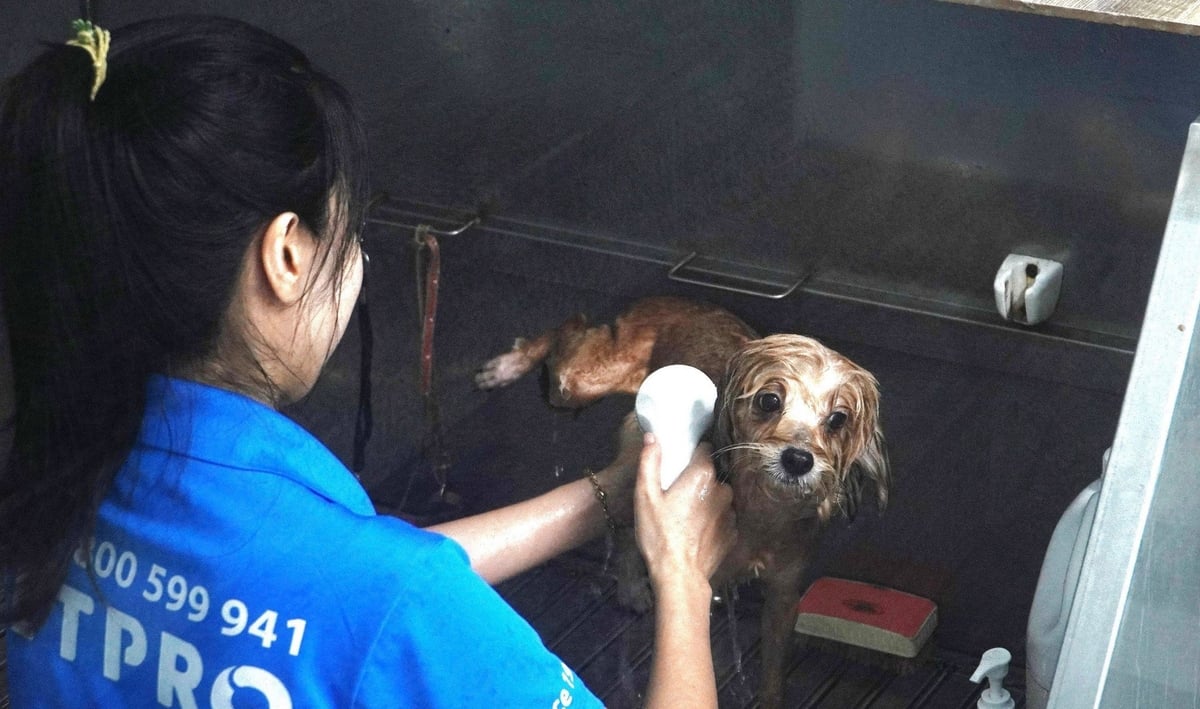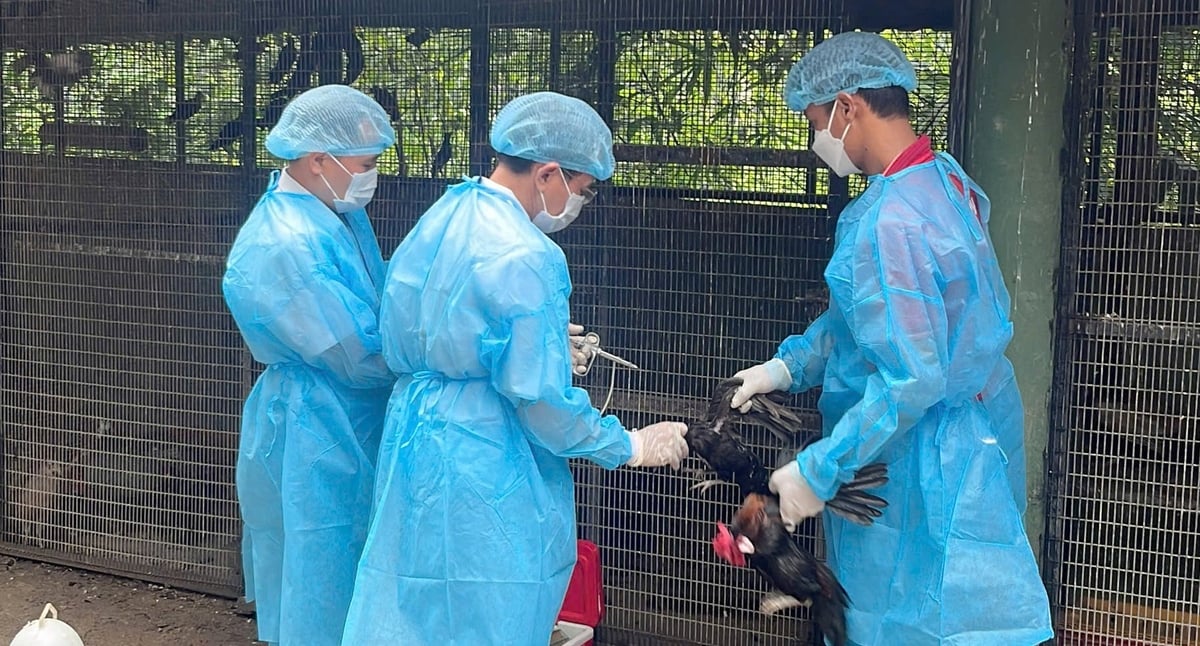December 22, 2025 | 23:43 GMT +7
December 22, 2025 | 23:43 GMT +7
Hotline: 0913.378.918
December 22, 2025 | 23:43 GMT +7
Hotline: 0913.378.918

Dong Nai veterinary force is taking fecal samples in the area where the A/H5N1 flu outbreak caused 21 tigers and leopards to die at Vuon Xoai Ecotourist Area. Photo: Le Binh.
Dong Nai is a hot spot for illegal slaughterhouses. This is a very tricky problem for the province's livestock production and animal health sector. Le Tan Viet, Head of the Livestock Production and Animal Health Station of Tan Phu District, has to face countless dangers during his work.
When Viet was tasked with detecting and punishing illegal slaughterhouses, there were times he thought he would have to be hospitalized or accept permanent injury.
“The subjects fiercely resisted when the interdisciplinary inspection team asked them to handle the evidence. I myself was also repeatedly held to my neck by knives or had objects thrown at me. At times like this, seeing my comrades bleed became normal,” he said.
One year ago, Dong Nai even recorded a case of 21 tigers and leopards dead at the Vuon Xoai Ecotourist Area. The cause was recorded as A/H5N1 avian influenza. This was “unimaginable” for Dong Nai’s veterinary force.
A/H5N1 flu was commonly known to be fatal to humans, but causing wild animals to get sick and die was unprecedented. Nguyen Truong Giang, Head of Dong Nai Sub-Department of Livestock Production and Animal Health, said, “At that time, we determined that isolating the epidemic area and cutting off the source of infection must be done as soon as possible, otherwise the consequences would be detrimental for the livestock capital. There was fear, because the feeling of danger was still too fresh, but no matter how difficult the task was, we had to do it. We just applied more precautions, like the time we tackled the Covid-19 pandemic, to protect ourselves.”
The danger is not only for the local anti-epidemic force but also for veterinarians at pet clinics. They often face pressure from pet owners, even negativity. Pets are usually very expensive dogs and cats, so if they die for any reason, the prejudice is "the doctor is to blame." That is the story that veterinarian Dang Minh Trung (District 12, Ho Chi Minh City) often encounters at his private clinic.
“There are pet owners who lose their temper after just a slight cold, urging the vet to prescribe a heavy dose of medication. However, when I advise them to just apply the medication as per instructions and the pet would recover in time, the owners insist on using the highest dose, even intravenous antibiotics. After a heated argument, some are ready to resort to physical aggression,” said veterinarian Minh Trung.

The growing trend of pet ownership is also a time when society needs a large number of veterinarians and veterinary staff. Photo: Le Binh.
The importance of veterinarians and human doctors has long been set on a rather awkward scale. Human doctors are recognized as “angels in white” in the prevention and treatment of human diseases. Veterinarians, on the other hand, are undervalued. The profession is sometimes viewed as a service industry.
When showing off her admission certificate to the veterinary medicine program at Ho Chi Minh City University of Technology (HUTECH), Tran Thi Mai (Duong Minh Chau district, Tay Ninh province) was somewhat scorned by her friends and relatives. Although Mai’s admission score was 27, almost the highest possible, others still thought she had chosen the wrong career.
“They often asked why I don’t study general medicine with such a high score, and studying veterinary medicine would make me a pig castrator or a cow breeder in the future. My relatives said it was foolish because doctors of human medicine are highly regarded, while being a veterinarian does not bring much fame or money,” she said.

Veterinarians are considered the front line in disease prevention and ensuring human health and safety. Photo: Le Binh.
That was also the story of Duong Van Phung, Head of Technical Department, Tay Ninh Sub-Department of Livestock Production and Animal Health, many years ago. Putting aside prejudices and criticisms, Phung was still determined to study veterinary medicine and return to his hometown to contribute.
When African swine fever (2020) and lumpy skin disease in cattle (2021) swept through Tay Ninh, he was one of the people who dedicated the most to stopping the epidemic and preventing it from spreading further. Thanks to ample efforts from Hung and colleagues, many livestock households in Tan Chau district were saved.
According to Dr. Le Quang Thong, Head of the Faculty of Animal Science and Veterinary Medicine, Nong Lam University Ho Chi Minh City, although their work is closely linked to public health, food safety and disease prevention in animals, veterinarians have not been evaluated commensurate with their contributions.
“At Nong Lam University Ho Chi Minh City, 100% of students admitted to veterinary medicine made it their first choice, which means they actively pursue the path from the beginning. The admission score for this major is also very high, ranging from 23 to 25 points, equivalent to the general medicine major of many universities. That clearly shows the change in the perception of the younger generation about veterinary medicine,” said Dr. Le Quang Thong.
Translated by Samuel Pham

(VAN) The 2025 Joint Response Plan (JRP) identifies three core priorities and calls for $96.2 million to support disaster recovery for 1.4 million people.

(VAN) Risk assessment methodology enables early risk identification, rational resource allocation, and the development of control measures tailored to the food value chain.

(VAN) Once considered a waste product to be burned, rice straw in the Mekong Delta is now being collected and processed through mechanization and biotechnology, paving the way for a sustainable circular agricultural model.

(VAN) Risk assessment in food safety management not only helps protect public health but also promotes sustainable development.

(VAN) Prime Minister chaired the 26th meeting of the National Steering Committee on Illegal, Unreported, and Unregulated (IUU) Fishing.

(VAN) Cuba is currently streamlining procedures to attract investors, with many new policies shaped by the practical experiences of Vietnamese projects operating in the country.

(VAN) Patrol Team No. 15 has been executing patrol, inspection, and control duties in the Southwest waters, a region identified as having a high risk of violations.